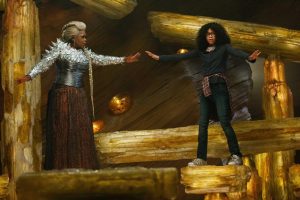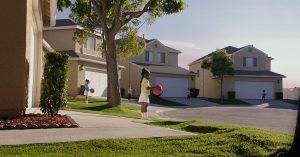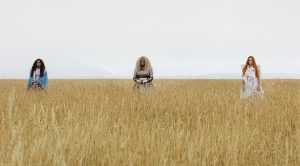![]() The 1962 book, A Wrinkle in Time, was one that completely passed me by growing up. However, it has developed a fervent following, now large enough to warrant a $105 million dollar cinematic adaptation. What transpires is noble in its intentions to promote love and a positive approach to life. However, as a drama and adventure that spans the universe, it never manages to build up a great deal in the way of thrills.
The 1962 book, A Wrinkle in Time, was one that completely passed me by growing up. However, it has developed a fervent following, now large enough to warrant a $105 million dollar cinematic adaptation. What transpires is noble in its intentions to promote love and a positive approach to life. However, as a drama and adventure that spans the universe, it never manages to build up a great deal in the way of thrills.
 Meg Murry (Storm Reid) is a young girl whose school work and attitude change for the worse when her astrophysicist father (Chris Pine) disappears. After 4 years, her child prodigy brother, Charles Wallace (Deric McCabe), believes he has found a lead in locating their dad. It comes in the form of three eccentric, costumed space-beings named Mrs. Whatsit (Reese Witherspoon), Mrs. Who (Mindy Kaling) and Mrs. Whitch (Oprah Winfrey). They explain that Meg’s and Charles Wallace’s father has gotten lost traversing the universe and agree to assist the kids and their pal Calvin (Levi Miller) in finding the missing scientist. These guides are a force of light, encouraging the children to ward off the evil darkness that is expanding from world to world.
Meg Murry (Storm Reid) is a young girl whose school work and attitude change for the worse when her astrophysicist father (Chris Pine) disappears. After 4 years, her child prodigy brother, Charles Wallace (Deric McCabe), believes he has found a lead in locating their dad. It comes in the form of three eccentric, costumed space-beings named Mrs. Whatsit (Reese Witherspoon), Mrs. Who (Mindy Kaling) and Mrs. Whitch (Oprah Winfrey). They explain that Meg’s and Charles Wallace’s father has gotten lost traversing the universe and agree to assist the kids and their pal Calvin (Levi Miller) in finding the missing scientist. These guides are a force of light, encouraging the children to ward off the evil darkness that is expanding from world to world.
 The kids are fine in their roles, if written a bit too perfect to be believed. I suppose in a kid’s film, one has to be open to the idea of a 6-ish child prodigy solving the mystery of a disappearance well before his scientist mother (who happened to be working on the very same project as her husband). The movie does boast some elaborate and colorful special effects as the leads use the “tesseract” to locate him. This amounts to traveling billions of miles through time and space by using their minds. A couple of the strange worlds offer some interesting imagery; in particular, a sinister environment that looks like a suburban tract out of the 1950s.
The kids are fine in their roles, if written a bit too perfect to be believed. I suppose in a kid’s film, one has to be open to the idea of a 6-ish child prodigy solving the mystery of a disappearance well before his scientist mother (who happened to be working on the very same project as her husband). The movie does boast some elaborate and colorful special effects as the leads use the “tesseract” to locate him. This amounts to traveling billions of miles through time and space by using their minds. A couple of the strange worlds offer some interesting imagery; in particular, a sinister environment that looks like a suburban tract out of the 1950s.
Unfortunately, there are some serious story issues that diffuse much of the excitement. There’s a lot of set-up establishing the astral visitors as personifications of light and positive energy, promoting individual strength and attempting to instill pro-activeness in the heroine. The attempt is admirable, although some very clunky humor is used to make the point. Mrs. Who only speaks in inspirational quotes and Mrs. Whatsit openly voices doubts about Meg (which seems like a contrast to what the character actually stands for). Many of these gags fall flat.
 But the major problem is the villain of the piece. Eventually referred to as IT, the being is visually portrayed as a mix between storm clouds and cells, also possessing tree-like features. After spending so much time developing manifestations of light, the film desperately needs a Mr. or Mrs. Darkness; some sort of physical manifestation to offer a creepy, even charismatic persona and tangible threat. Instead, the kids essentially face off against weather patterns. Towards the end, IT does use a character or two as a puppet, but this antagonist has no strong identity and doesn’t make an impression. And when Meg finds inspiration to face her foe, much of the action is oddly scored with pop tunes. As a result, there is no drama or anxiety generated.
But the major problem is the villain of the piece. Eventually referred to as IT, the being is visually portrayed as a mix between storm clouds and cells, also possessing tree-like features. After spending so much time developing manifestations of light, the film desperately needs a Mr. or Mrs. Darkness; some sort of physical manifestation to offer a creepy, even charismatic persona and tangible threat. Instead, the kids essentially face off against weather patterns. Towards the end, IT does use a character or two as a puppet, but this antagonist has no strong identity and doesn’t make an impression. And when Meg finds inspiration to face her foe, much of the action is oddly scored with pop tunes. As a result, there is no drama or anxiety generated.
Finally, while earnest, the denouement resorts to too many saccharine hugs, cornball sentiment and clunky exchanges between the characters. The ideas are certainly there, but the screenplay never really does the drama any service, leading to an adventure that is entirely underwhelming. I admired individual scenes in A Wrinkle in Time, but as a whole the movie doesn’t provide the sense of wonder and excitement hoped for.


